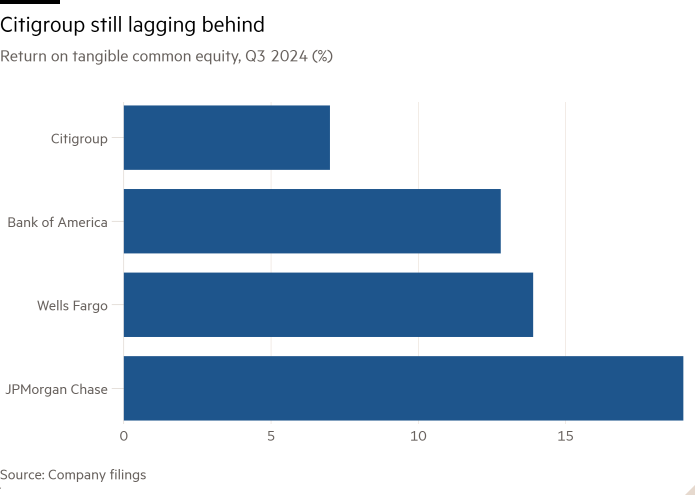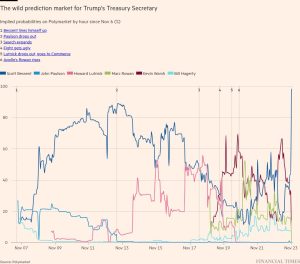Citi’s comeback is capped by regulatory threat

Unlock the Editor’s Digest for free
Roula Khalaf, Editor of the FT, selects her favourite stories in this weekly newsletter.
In teen slang, “no cap” means “for real”. For Citigroup investors, the two words could decide whether they hang on to the stock or not.
Since last September, when chief executive Jane Fraser unveiled what she called Citi’s biggest reorganisation in almost two decades, shares in America’s fourth largest bank by assets have shot up more than 50 per cent. That looks impressive. But it is merely in line with rivals JPMorgan Chase, Bank of America and Wells Fargo. On a price to tangible book value basis, Citi remains heavily discounted. The ratio, at just 0.7 times, is the lowest among the big US banks.
Regulatory overhang is the biggest obstacle to Fraser’s plans to revive Citi’s fortunes. The bank is working through two consent orders to fix shortcomings in its risk management, data management and internal controls.
Despite spending billions since the orders were imposed in 2020, regulators slapped Citi with a $136mn fine this summer for insufficient progress. Senator Elizabeth Warren has called for growth restrictions to be placed on Citi, arguing it had become “too big to manage”. An asset cap, among the harshest punishments regulators impose on US lenders, is a block on increasing the balance sheet above a certain level, curbing revenues and earnings.
Fraser said, at third-quarter results this week, that Citi was not under a cap and insisted none were expected. Still, questions about a potential limit — days after regulators hit Canada’s TD Bank with one — is a distraction that Citi does not need.

The results underscored how much work is left to do. Return on tangible common equity — which Fraser has vowed to improve — was a dismal 7 per cent. Net income was 9 per cent lower amid rising credit card loan defaults and a decline in net interest income. Services, which offers working capital and payment facilities to companies, remains a bright spot and investment banking (like elsewhere on Wall Street) had a standout quarter.
Citi has been aggressively cutting costs. Third-quarter operating expenses were down 2 per cent year on year. But its efficiency ratio, a measure of expenses to revenue, was 65.2 per cent in the third quarter. That is down from the 67.1 per cent reported a year ago but still well above the 53 per cent at BofA and JPMorgan.
Regulatory clean-ups are expensive. Citi must spend to fix the areas where regulators require faster progress, complicating efforts to bring costs down. Fraser, who was already trying to demonstrate that Citi had shaken off its tendency for unfortunate mis-steps, may struggle to reassure investors that Citi’s turnaround can continue “no cap”.
#Citis #comeback #capped #regulatory #threat





